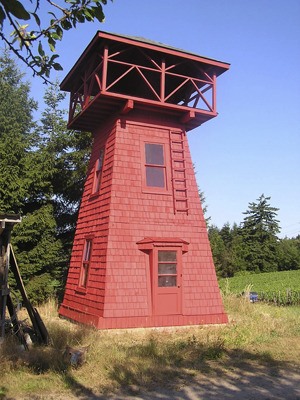By BARBARA WINTHER
For the Review
If you drive east on Day Road to Suyematsu’s farm, where the berry and vegetable stand operates, you will see the Hoskinson/Pratt Water Tower, a tall, red-shingled building. It stands there because the City of Bainbridge Island and its Historic Preservation Commission (HPC) saved it. Why and how was this done?
Pioneer Riley M. Hoskinson came to Bainbridge Island in 1878, homesteading 160 acres in the middle of present-day Winslow (Madrone until 1903).
Around 1892, on the northeast corner of today’s Wyatt and Madison avenues, Riley’s son, William, built a home. In 1907 he sold the property to John Robinson Pratt and his wife, Ella Mae. According to their son, Carl, the family erected the water tower in 1912; Carl’s daughters remember playing dress-up in its base and fetching preserves stored there.
Eventually the property was sold again. Over the years the home was used by business enterprises and the tower served various local artists as a studio. Unable to keep up with repairs, the owner, Marion Moriarty, sold the property to a developer who planned to build condos on the land.
In 2005 the developer offered the home and the water tower to anyone who would move them. Nobody took the house and it was torn down. However, after a structural analysis and advice from HPC, the city agreed to save the water tower.
Where on city property should it go? One idea was the vacant land at the corner of State Route 305 and Winslow Way. But the earth at the former Unocal site was still contaminated. Perhaps in the round-about on High School Road? No, it might be a trafic hazard. Beside City Hall? Not enough room. Next to the Farmer’s Market? It would limit space for farmers’ booths.
Then Linda Owens and Betsy Wittick of the Farmer’s Market Association suggested installing the tower on the city’s property on Day Road as a beacon for surrounding farms. Gerard Bentryn of the winery and Bart Berg of the Trust for Working Landscapes staked out a flat area.
The farmers were thrilled. Since Madrone/Winslow was an agricultural community in its early days and water towers were an integral part of farming, placing the historic tower in a similar setting was a reminder of the island’s roots.
The tower endured a hair-raising trip through the round-about and up SR-305 to its new home. Paul Storey and Roger Keys, lowest bidders for minimum restoration, poured the foundation, and after the tower was craned into place, secured the tower to it, reattached the top section, reroofed it and then built a new floor.
Realizing the city’s money shortage, they donated extra hours of work. The city’s maintenance department added missing shingles, repaired windows and installed the door (purchased at a Rotary Auction by a HPC member). Winslow Paint’s Mary Hall talked Cabot Company into giving paint and painter Vincent Fouchi donated his services to pressure wash and spray paint the tower.
Truly this was a COBI/HPC/community effort to save a significantly historical structure deeply embedded in our island’s past.
Barbara Winther was chair of the HPC during the water tower negotiations.


